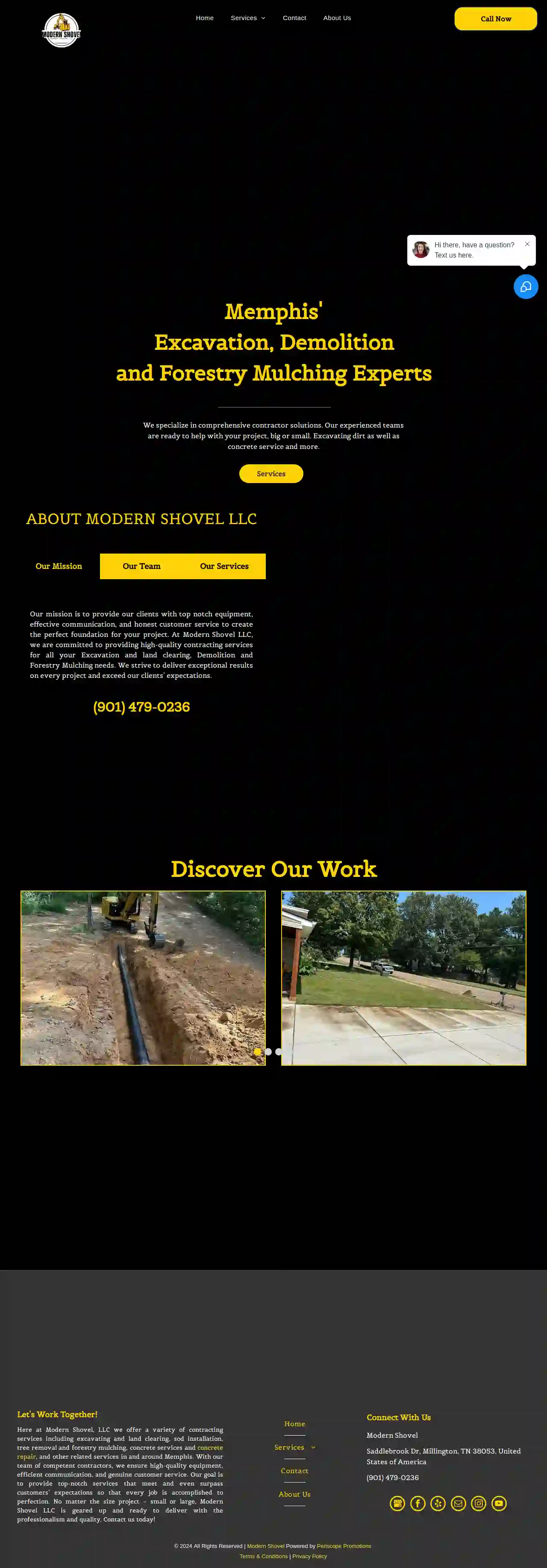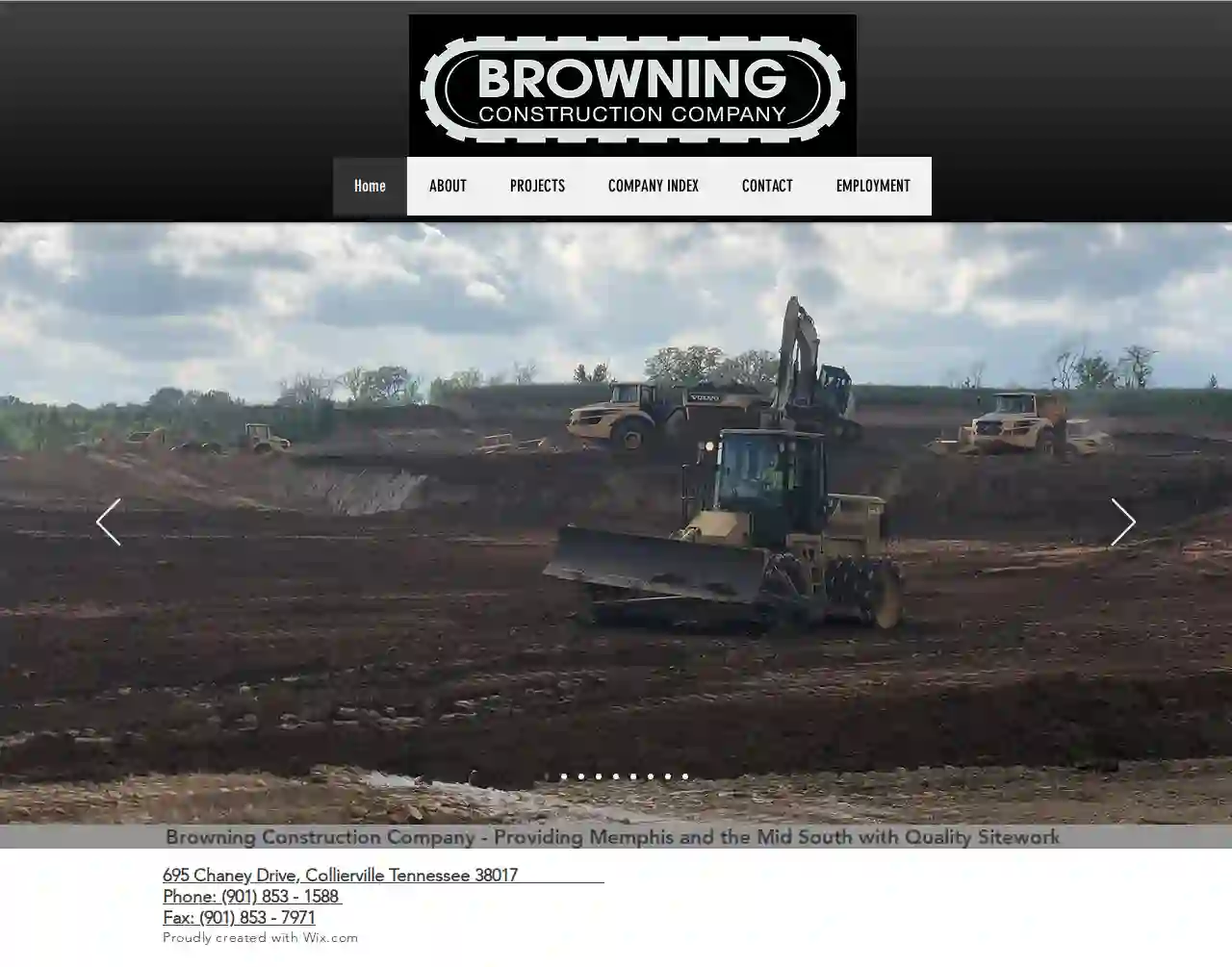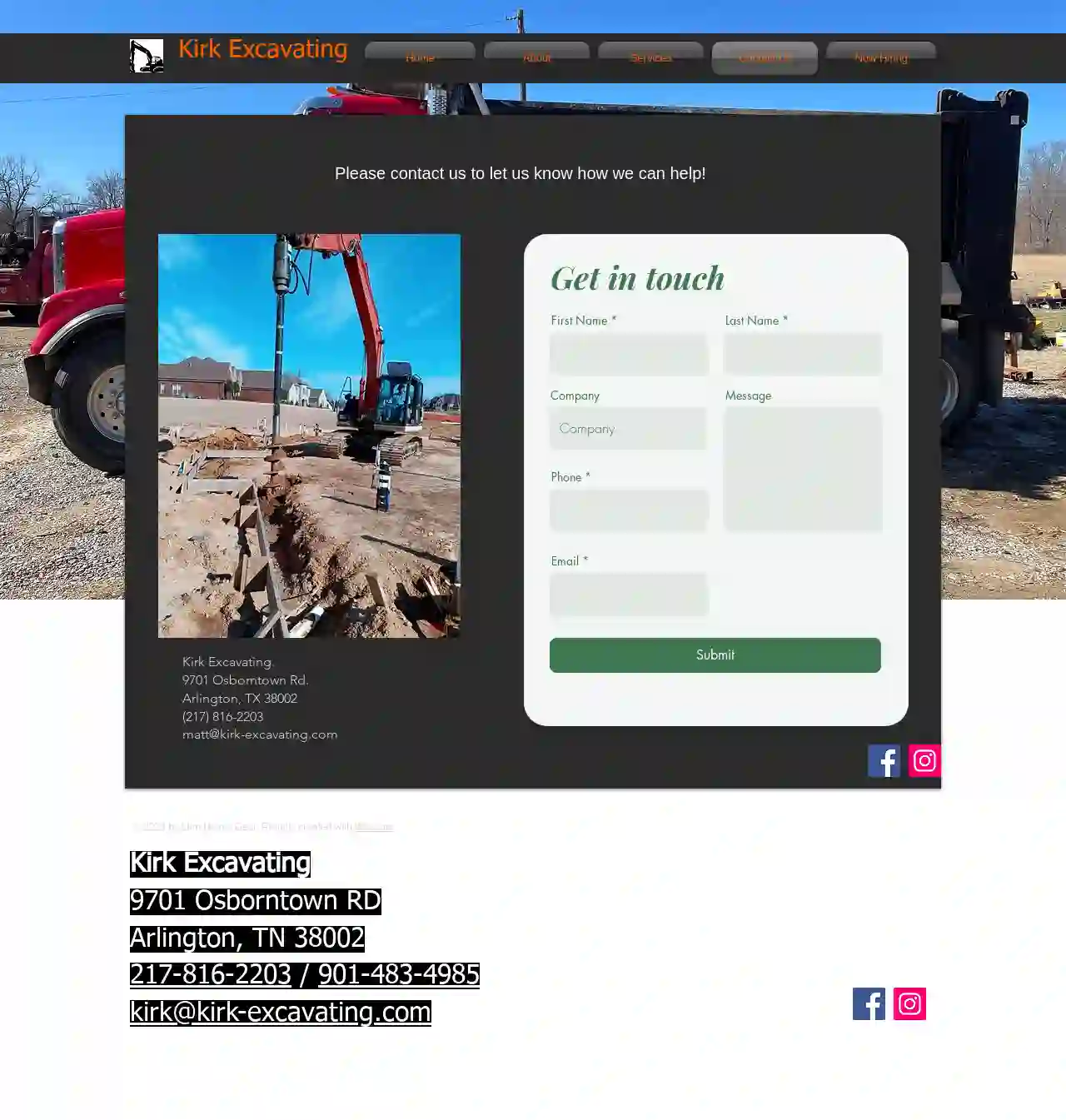Excavation Contractors Memphis
Find the best Excavation Contractor in Memphis
Receive up to 3 Excavation Company Near Me quotes for your project today! Compare profiles, reviews, accreditations, portfolio, etc... and choose the best deal.

A to Z Construction Services LLC General Contractor
4.540 reviews581 Vandalia Street, 581 Vandalia Street Memphis, TN, Memphis, 38112, USA to Z Construction Services LLC General Contractor specializes in commercial general contracting, expertly overseeing construction projects that cater to the unique needs of businesses in the community. A to Z Construction Services LLC General Contractor, is a general contractor in Memphis, TN. We are a building and construction company providing general contracting services for homes and businesses. Established in 1991, we specialize in the renovation and repair of residential, multi-family and commercial properties. Our services include roof replacement, home improvement and quite a bit more.Our broad range of products and services gives us more options to fulfill your requests. We give you plenty of choices. Whether you need an addition or would like to add curb appeal to your home or business, our experienced staff is ready to help. Contact us today! We strive to always operate with the highest level of integrity and commitment to excellence. From on-time schedule completion through final product perfection, you can count on our cost-effective process from beginning to end. A to Z Construction Services LLC General Contractor is a name you can count on to deliver what we promise when we promise it. Our word is our bond. As a trusted general contractor, we work hard to provide our clients with honesty and integrity in all that we do.
- Services
- Why Us?
- Accreditations
- Gallery
Get Quote
Modern Shovel
525 reviewsSaddlebrook Dr, Millington, 38053, USOur Mission At Modern Shovel LLC, we are committed to providing high-quality contracting services for all your Excavation and land clearing, Demolition and Forestry Mulching needs. We strive to deliver exceptional results on every project and exceed our clients' expectations. Our Team Our experienced contractor team is a well-oiled machine when it comes to providing exceptional services. Their precision, expertise, and commitment to excellence ensure that every project is executed flawlessly, setting the bar high in the excavating dirt industry. Our Services We offer a wide range of contracting services for our clients in and around Memphis TN, including land clearing, sod installation, tree removal and forestry mulching, ditch digging, culvert installation, large scale landscaping, and countless others. No matter what your project entails, we have the expertise and resources to get the job done right.
- Services
- Why Us?
- Our Team
- Gallery
Get Quote
Browning Construction Company
4.26 reviews695 Chaney Drive, Collierville, 38017, USAbout Browning Construction Company Browning Construction Company is a leading provider of quality sitework services in Memphis and the Mid South. We have a proven track record of success, and we are committed to providing our clients with the highest level of service and workmanship. Our team of experienced professionals is dedicated to meeting your needs and exceeding your expectations. We are proud to be a part of the Memphis community, and we are committed to providing our clients with the best possible experience. Our Mission Our mission is to provide our clients with the highest quality sitework services at a fair price. We are committed to safety, quality, and customer satisfaction. We believe in building strong relationships with our clients, and we are dedicated to providing them with the best possible experience. Our Services We offer a wide range of sitework services, including: Grading Excavation Site preparation Utility installation Paving Drainage Retaining walls And more Our Team Our team of experienced professionals is dedicated to providing our clients with the highest level of service and workmanship. We are committed to safety, quality, and customer satisfaction. We believe in building strong relationships with our clients, and we are dedicated to providing them with the best possible experience. Our Experience We have a proven track record of success, and we are committed to providing our clients with the highest level of service and workmanship. Our team of experienced professionals is dedicated to meeting your needs and exceeding your expectations. We are proud to be a part of the Memphis community, and we are committed to providing our clients with the best possible experience.
- Services
- Why Us?
- Gallery
Get Quote
Lesley Contractors
1400 Bob Taylor Drive, Marion, 400 Bob Taylor DriveMarion, 72364, USAbout us Lesley Contractors, LLC is a utility contracting company, established in 2003, and owned and operated by Jerry Lesley. Jerry and his team serve the mid-south with over 20 years of experience specializing in directional boring. Lesley Contractors believes in performing each job, whether large or small, with integrity, providing our customers with complete quality service. We specialize in servicing utility and cable corporations and small business contractors in Arkansas, Tennessee, and Mississippi. Whether its electrical, plumbing, water, or fiber optics, we have the knowledge and experience necessary to meet your utility needs. What We Do Lesley Contractors, LLC specializes in directional boring, providing services for both commercial and residential customers. Directional Boring, sometimes referred to as “trenchless technology,” utilizes special machines that install underground pipe or conduit with no impact or damage to surface areas such as lawns, landscaping, concrete, pavement, and structures. It also offers the best option for high traffic or sensitive areas because there is no disruption to traffic flow when going under roadways. With Directional Boring you can accomplish more with less, and that’s exactly what we do at Lesley Contractors. With the use of advanced technology, we take pride in accurately hitting your targets no matter the depth or range. Give us a call and let us “Drill It” for you! We can bore under anything! Parking Lots Driveways Roadways Homes, Office Buildings and Other Structures
- Services
- Why Us?
- Gallery
Get Quote
Precision Ground Solutions LLC
1228 Littleton Way, Munford, 38058, USAbout Us We provide many different services including: installing/improving gravel driveways, bushhogging, land leveling, land clearing, sod, water drainage problems, etc. We have recently added landscape lighting to our services! Prompt and Reliable We believe in completing jobs as quickly and precisely as possible. Satisfaction Guaranteed With over 20 years of experience in operating equipment, we take pride in our finished work.
- Services
- Why Us?
- Gallery
Get Quote
W.G. Yates & Sons Construction Company
53 reviewsMemphis, US- Services
- Why Us?
Get Quote- Po
Porterco LLC
53 reviewsMemphis, USWe are a local business dedicated to providing high-quality services to our community. Our team is committed to exceeding your expectations and delivering exceptional results. We are passionate about what we do and strive to build lasting relationships with our clients. Contact us today to learn more about how we can help you achieve your goals.
- Services
- Why Us?
- Gallery
Get Quote 
Baldwin & Shell Construction Company
32 reviewsMemphis, US- Services
- Why Us?
Get Quote
Kirk Excavating
19701 Osborntown Rd., Arlington, 38002, USKirk Excavating Please contact us to let us know how we can help!
- Services
- Why Us?
- Gallery
Get Quote
Perdew Excavating
1Memphis, USThis Townsquare Interactive website is no longer available. If you have any questions please feel free to contact our support team at: [email protected]
- Services
- Why Us?
- Gallery
Get Quote
Over 3,943+ Excavation Pros onboarded
Our excavation contractors operate in Memphis and beyond!
ExcavationHQ has curated and vetted Top Excavation Contractors in Memphis. Find a trustworthy business today.
Frequently Asked Questions About Excavation Contractors
- Project Size and Scope: The larger and more complex the excavation, the higher the cost.
- Soil Type: Different soil types require different equipment and techniques, impacting costs. Rocky or clay-rich soil can be more expensive to excavate than loose soil.
- Accessibility: Difficult-to-access sites might require specialized equipment or additional labor, increasing expenses.
- Disposal Costs: Hauling away excavated material (soil, rocks, etc.) to disposal sites incurs additional fees.
- Permits and Inspections: Depending on local regulations, permits and inspections might be required, adding to the overall cost.
- New Construction: Laying foundations, basements, or underground utilities for new buildings.
- Home Additions: Creating space for new rooms, basements, or extensions.
- Landscaping: Leveling ground, creating slopes, installing retaining walls, or digging for ponds or pools.
- Drainage Improvement: Installing French drains, drainage ditches, or swales to manage water runoff.
- Utility Installation or Repair: Laying new water, sewer, gas, or electrical lines, or repairing existing ones.
- Demolition: Clearing debris and preparing the site after demolishing a structure.
How much does excavation cost?
What is the difference between excavation and grading?
Excavation: Primarily involves removing earth or other materials from a site. It's about digging down and creating space.
Grading: Focuses on shaping and leveling the ground to a specific slope or elevation. It's about adjusting the existing terrain.
For example, you might excavate a foundation and then grade the surrounding area to ensure proper drainage and a level surface for landscaping.
How do I know if I need excavation for my project?
What is the difference between topsoil and subsoil?
Topsoil: The uppermost layer, typically rich in organic matter, nutrients, and microorganisms. It's essential for plant growth and is often darker in color.
Subsoil: The layer beneath the topsoil, containing less organic matter and generally denser. It provides support for roots but is less fertile than topsoil.
During excavation, topsoil is often removed and preserved separately for later use in landscaping, while subsoil is typically used for backfilling or other less demanding applications.
How much does excavation cost?
- Project Size and Scope: The larger and more complex the excavation, the higher the cost.
- Soil Type: Different soil types require different equipment and techniques, impacting costs. Rocky or clay-rich soil can be more expensive to excavate than loose soil.
- Accessibility: Difficult-to-access sites might require specialized equipment or additional labor, increasing expenses.
- Disposal Costs: Hauling away excavated material (soil, rocks, etc.) to disposal sites incurs additional fees.
- Permits and Inspections: Depending on local regulations, permits and inspections might be required, adding to the overall cost.
What is the difference between excavation and grading?
Excavation: Primarily involves removing earth or other materials from a site. It's about digging down and creating space.
Grading: Focuses on shaping and leveling the ground to a specific slope or elevation. It's about adjusting the existing terrain.
For example, you might excavate a foundation and then grade the surrounding area to ensure proper drainage and a level surface for landscaping.
How do I know if I need excavation for my project?
- New Construction: Laying foundations, basements, or underground utilities for new buildings.
- Home Additions: Creating space for new rooms, basements, or extensions.
- Landscaping: Leveling ground, creating slopes, installing retaining walls, or digging for ponds or pools.
- Drainage Improvement: Installing French drains, drainage ditches, or swales to manage water runoff.
- Utility Installation or Repair: Laying new water, sewer, gas, or electrical lines, or repairing existing ones.
- Demolition: Clearing debris and preparing the site after demolishing a structure.
What is the difference between topsoil and subsoil?
Topsoil: The uppermost layer, typically rich in organic matter, nutrients, and microorganisms. It's essential for plant growth and is often darker in color.
Subsoil: The layer beneath the topsoil, containing less organic matter and generally denser. It provides support for roots but is less fertile than topsoil.
During excavation, topsoil is often removed and preserved separately for later use in landscaping, while subsoil is typically used for backfilling or other less demanding applications.